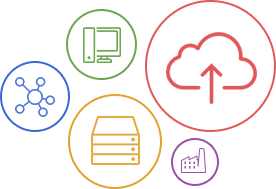
Unpredictability and change are both constants of life. During these unprecedented times, you just can’t predict what will happen next. The same goes for business. One day you’re up, the next you’re down. It’s a matter of putting the necessary measures to make sure that you always get back up.
When it comes to IT, it’s no different.
Businesses face a plethora of challenges every single day. It comes with the territory. Natural disasters such as hurricanes, earthquakes, and power outages may all cause damage to your infrastructure. And, in the same breath, man-made problems like ransomware and other types of malware can all contribute to the disruption of normal day-to-day business operations.
Scary, right? But all hope is not lost.
In a world where data is king, it’s important for businesses to protect their data 24/7/365. The problem is, not everyone’s familiar with the basic measures to ensure that their data is always safe and secure. Let’s talk about backup and disaster recovery solutions.
What is Disaster Recovery Planning?
Don’t let the term overwhelm you. A backup and disaster recovery plan is simply a guide or strategy developed by your IT department, an IT consultant, or a managed IT services provider that allows you to restore your data after an unplanned incident. Like most things, you can scour the web for things like "disaster recovery plan sample" or "disaster recovery planning template" but, the truth of the matter is, they won't work as well as you would like them to. The benefits of disaster recovery planning depends on the solutions you put in place that's unique to your business needs.
A disaster recovery plan should also be part of your IT strategy checklist. Think of disaster recovery as some sort of insurance that protects you from unforeseen risks. You may not need it but it’s comforting to know that it’s there. Having a disaster recovery plan means you can minimize the impact of downtime, speed-up recovery, and restore and secure sensitive information. The importance of disaster recovery planning can be summarized in three words: peace of mind.
Solutions Review published a great article about disaster recovery practices which highlighted the rise of global ransomware attacks. Here’s a quick and easily-digestible summary:
- 45% of unplanned downtime is due to hardware failure
- 30% of businesses had NO disaster recovery plan in place
- 33% of businesses were unprepared for an attack even though there was a recovery plan in place
- 35% of unplanned downtime is due to power outages
- 90% of businesses without a disaster recovery plan will fail in the aftermath of a disaster
- 12% of companies were unable to recover the data they lost
- The process of recovering from a disaster takes up 25% of staff time
(Source: By the Numbers: Improve on 2017 Disaster Recovery Practices)
If that’s not enough to scare you into developing a disaster recovery plan for your business at this very moment, then we don’t know what will. Regardless of business size, your business could not afford even an hour of downtime. Whether you’re a private company or a public organization, you need to know how your operations can keep going under dire circumstances. Having a disaster recovery plan in place helps your company identify potential threats and develop initial responses to mitigate the risk of further data loss.
Business continuity is important for all types of businesses and implementing a measurable contingency plan tailored to your business’ needs is of utmost importance. Developing, implementing, and maintaining a disaster recovery plan seems tedious but it is essential. Determining weak points in your system is always a good thing considering the uncertainties of today’s fast-paced world.
However, it doesn’t stop with disaster recovery planning. You should also have regular backup measures.
What is data backup or database backup?
Another key feature that your IT strategy checklist should have is a data backup plan. No matter how efficient your network seems to be, there will always be a slight chance that a single unprecedented incident can affect your system and result in data loss. To better understand data backup, let’s take a look at some of its most common types.
Onsite backup vs Offsite backup
Onsite backup refers to storing data on a storage device such as hard drives and on-site servers. On the other hand, offsite backup is the practice of storing your data using the cloud. This means that your data is stored in remote locations that you can access as long as you have a stable internet connection. Data backup on cloud or data backup online is considerably safer and cost-effective since hardware for a local server can be costly.
Is one better than the other? It depends. Where you store your data depends on your business’ needs as each business has its unique requirements. The best thing to do is to look into your business and determine whether an onsite backup, an offsite backup, or a combination of both is right for your needs.
What are the 3 types of backups?
There are multiple types of data backup services. Here are three of the most common types of database backup.
What is a full backup?
Simply put, a full backup is when every single file in your system is backed up. Considered as the most basic and most complete type of backup, a full backup makes a copy of all of your data and stores these copies in an onsite or offsite storage. The biggest downside of a full backup is that it requires more time to store your data and takes up more storage space.
What is an incremental backup?
Incremental backups, according to TechTarget, are backups that only copy data that has been modified since the last backup operation. This means that incremental backups take less space and are much quicker compared to full backups.
What is a differential backup?
A differential backup is somehow similar to an incremental backup. The main difference is that differential backups rely on the last full backup to determine which new and modified data to make copies of and backup. When it comes to restoring data, differential backups only need the last full backup and the last differential backup.
Sounds like a lot to take in? Well, it is. But remember, keeping yourself informed about the benefits of the different kinds of backups and the benefits of disaster recovery planning can help your company avoid downtime and data loss. It doesn't matter if you have measures in place for data backup on cloud or a local server, the important thing is having a solution in the event of data loss.
So do you need a Backup and Disaster Recovery Plan?
Of course. It doesn't matter if data is compromised by a natural disaster, malware, equipment malfunction, or a data breach, it is bound to create a significant disruption to your business. Having a backup and disaster recovery plan means one more layer of protection that can help get your company’s operations back on track. There are even data backup for iPhone and data backup for Android - so why can't your business have the same?
After all, what’s more important than keeping your business going, right?
About ETech 7
ETech 7 is a managed IT services company dedicated to providing superior quality service to a wide range of businesses. Leveraging state of the art software and world-class service, ETech 7 strives to deliver affordable and reliable solutions for all your IT needs. Any business of meaningful size needs computer networking, backup and disaster recovery. ETech 7 allows companies to outsource professional setup, routine maintenance, emergency assistance, and project development.












